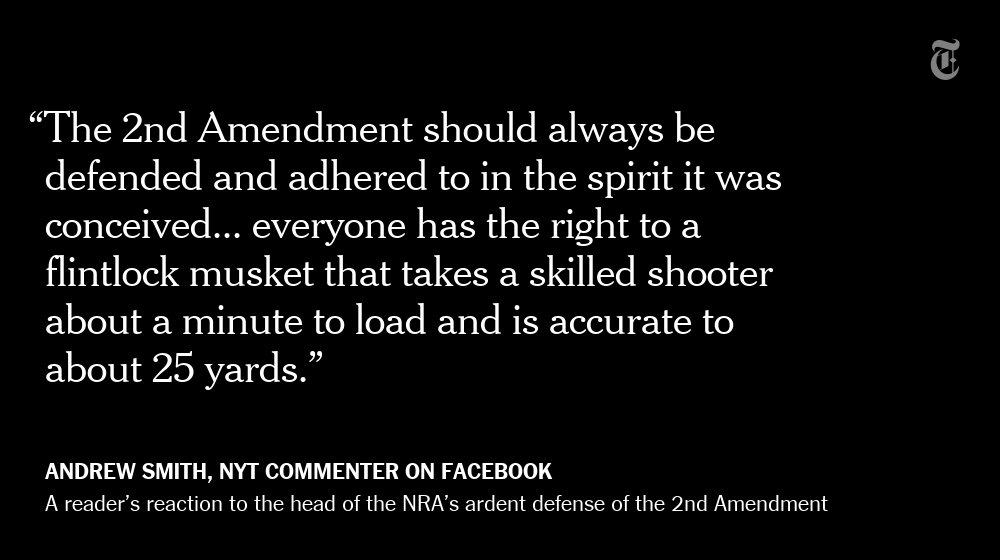Constitutional Cherry Picking: Unpacking the Second Amendment
 National Rifle Association Chief, Wayne Lapierre, is a staunch supporter of the 2nd Amendment and opposes gun control
http://bit.ly/2p05H3A
National Rifle Association Chief, Wayne Lapierre, is a staunch supporter of the 2nd Amendment and opposes gun control
http://bit.ly/2p05H3A
Just over two months into 2018, the United States has already seen 36 mass shootings – that is, shootings where four or more people were injured or killed as a result of gun violence. With almost half of the world’s guns and 31% of the world’s mass shooters in the United States alone, the comparison to the rest of the international community is stark. There is a unique culture of gun ownership in the US that exists almost nowhere else, and is consistently justified by the 229-year-old Second Amendment. Shooting after shooting, the conversation surrounding gun control is stifled by (largely Republican) legislators’ commitment to a seemingly straightforward component of the constitution: “A well regulated Militia, being necessary to the security of a free State, the right of the people to keep and bear Arms, shall not be infringed.”
The standout phrase: “the right of people to keep and bear Arms.” To most Americans, the constitution represents their fundamental, unalienable rights–regardless of the type of firearm in question. So, the conversation on gun control ends there – and dangerously so. The phrase is cherry picked out of the full amendment, taken at face value, and most importantly, used independently of historical context. The truth is that the right to bear arms was given in a specific context that warranted such a measure, where military technology and the political climate were entirely different from today’s; and though legislation like this isn’t timeless, it’s consistently used as though it were.
Two Centuries of Democracy and Sovereignty in the Making
The Second Amendment was born over 220 years ago in the context of the American Revolution, when bearing arms and the existence of militias were essential to the colonies’ victory over Britain – hence, the phrase deeming a well-regulated militia “necessary to the security of a free State”. As a newborn state accustomed to tyrannical rule and the infringement of rights, the goal in writing the Constitution was to create something that would keep just that from happening again. Thus, it is necessary to take the Second Amendment as a whole: the right to bear arms goes hand in hand with the terms “militia” and “well-regulated” and is most importantly bound to the protection and “security of a free State”.

The Second Amendment came about as a measure to prevent the tyranny of the state and for citizens to legally defend their freedom should such a regime come about – not to facilitate hunting, recreational shooting, or individual ‘protection’. Two centuries ago, the hostility of Britain, the socio-political instability of such a young country, and the nonexistent army made the right to bear arms necessary. Two things existed at that time that don’t today: an incentive for the US to cement itself as a legitimate, sovereign state, and the volatility of a newly-built democracy. 229 years later, however, the United States is an economically-thriving superpower with a reputation for upholding democratic values and the largest military in the world. Its status as a consolidated democracy is over two centuries years old, and the risk of oppressive behaviour from the state is virtually non-existent.
Since its implementation, American statehood has solidified and undergone vast changes that largely negate the legitimacy of the Second Amendment as it is understood – or misunderstood – today. Yet, despite the obvious historical context, the conversation’s focal point remains individual rights.
Technological Newcomers and Game Changers
In 1789, the term ‘arms’ meant dueling pistols, muskets, bayonets and rifles. Guns took even skilled soldiers 30 seconds to load, misfired almost half of the time, and were accurate to around 100 yards. Even loaded and fired accurately, muskets and flintlocks had a one-round capacity, and could only fire three rounds per minute. Today, an AR-15 can accurately fire 600 yards away, at 45 rounds a minute, and functions without the cumbersome task of reloading with gunpowder. In the words of Andrew Smith, a New York Times commenter on Facebook: “The 2nd Amendment should always be defended and adhered to in the spirit it was conceived…everyone has the right to flintlock musket that takes a skilled shooter about a minute to load and is accurate to about 25 yards.” The staggering disparity between guns then and now makes it difficult to realistically envision an 18th century gun causing half of the damage of the average modern mass shooting.
This leaves two implicitly communicated fears of the Second Amendment unattended: the fear of invasion, and the fear of an oppressive state – but even these are nullified by technological and military advancements. The United States boasts the largest, most funded military in the world as well as one of the largest economies. Its hard and soft power are almost uncontested and serve as powerful deterrents, rendering the necessity for a militia or armed citizens completely obsolete. Simply put, it is no longer the average citizen’s job to defend the state, nor is it even logistically possible. Though average American citizens have access to a vast array of weapons with no rational purpose in everyday life, and could theoretically assemble themselves into an organized militia contesting state legitimacy, Washington’s monopoly on legitimate violence and the U.S. military’s technological superiority are unprecedented in human history.
Beyond this, the United States’ long-standing commitment to democracy makes the prospect of an authoritative state unlikely. Even in entertaining such a scenario, one would be hard-pressed to see how the AR-15s of America would prevent it. Technological advancements have far from escaped the US government, which now enjoys access to drones, fighter jets, and nuclear weapons. Though the (almost impossible) idea of an oppressive government with such capabilities is discouraging at best, it makes a greater point: civilian gun ownership simply could not defend the state from a tyrannous regime, further making the unregulated access to guns unjustified.
Simply put, the use of the Second Amendment as it stands in contemporary American life is as unjustified as using the Third Amendment would be. The clause, which restricts the quartering of soldiers in private homes, was similarly written in the context of American Revolution in response to the British-imposed Quartering Acts. It stands close by the Second Amendment, but is rarely invoked or deemed relevant today — in fact, it has never served as the basis of a Supreme Court decision. It rivals the Second Amendment in its historical detachment, but has been met with an entirely different response; one that further demonstrates amendments are not contextually stagnant.

Hypocrisy and Faulty Logic
In the last 200 years, weapons, technology, concerns and political priorities have far outgrown the Second Amendment. Guns and the political context have changed, and yet, the legislation remains frozen in the 18th century. Misunderstandings plague the employment and understanding of the amendment. For example, there is a wide-spread assumption that regulation is synonymous with the infringement of a basic right instead of being a precaution – despite the phrase “well-regulated” being explicitly used in the clause itself.
What’s more, the nonexistent regulation of gun ownership and use is inexplicably contrasted by the regulation of other heavy, dangerous machinery. There is no question, for instance, surrounding the right of everyone to own and drive a car, should they meet the regulations. There is also no question about the legitimacy or necessity of traffic and driving regulations. Instead, the existence of driving ages, theory and practical tests, licences, registrations, traffic laws, speed limits, and the requirement for psychological stability are universally accepted. Nothing, however, mirrors this reasoning in the debate on guns, despite the fact that cars and guns alike, especially when mishandled, are dangerous. Cars, however, have an inherent, everyday, practical purpose. Guns, on the other hand, do not. They were designed — by and large — with the explicit purpose to inflict harm and death; thus, the nature of the object in itself logically demands stricter regulation. What’s more, the vast majority of Americans — Republicans and Democrats alike — actually support stricter gun laws.
Despite the case for gun regulation sitting right under the noses of Republican legislators, no change follows. It thus begs the question: was the case against gun control ever really about fundamental rights, or something else entirely?
Edited by Benjamin Aloi
